Take out of the box

protective plastic sheet 1 pc

protective goggles 2 pairs

protective gloves 2 pairs

tray 1 pc

beaker 1 pc

spoon

Petri dish 1 pc

dry sand 100 g

starch 200 g

dye 30 ml
Prepare at home:

cold water 200 ml

paper towels
 FIRST AID INFORMATION
FIRST AID INFORMATION
In case of contact with the eye(s): wash out the affected eye with plenty of water, holding the eye open if necessary. Seek immediate medical advice.
If swallowed: wash out the mouth with water, drink some fresh water. Do not induce vomiting. Seek immediate medical advice.
In case of inhalation: remove person to fresh air.
In case of skin contact and burns: wash the affected area with plenty of water for at least 10 minutes.
If in doubt, seek medical advice without delay. Take the chemical and its container with you.
In case of injury always seek medical advice.
 ADVICE FOR SUPERVISING ADULT
ADVICE FOR SUPERVISING ADULT
Each SmartBee kit is intended for conducting experiments for children over 8 years of age. Because children’s abilities vary so much, even within age groups, supervising adults should exercise discretion as to which experiments are suitable and safe for their children.
Read and follow these instructions, the safety rules and the first aid information, and keep them for reference.
Be sure to thoroughly discuss the warnings and safety information with your child or children before commencing the experiments. Follow them and keep them for reference. Remember: misuse of chemicals can lead to injury or cause serious harm to health.
Carry out only those experiments that are listed in the instructions, using the equipment provided in the kit.
The area surrounding the experiment should be kept clear of any obstructions and away from the storage of food. It should be well lit and ventilated and close to a water supply.
A solid table with a heat resistant top is recommended for carrying out the experiments.
 SAFETY REGULATIONS
SAFETY REGULATIONS
Read these instructions before use, follow them, and keep them for reference.
Keep young children, animals and those not wearing eye protection away from the experimental area.
Always wear eye protection.
Store this experimental set out of reach of children under 8 years old.
Clean all equipment after use.
Make sure that all containers are fully closed and properly stored after use.
Ensure that all empty containers are disposed of properly.
Place the protective sheet on the table.



Put on the safety glasses.



Pour 2 tablespoons of sand onto the Petri dish and level the surface.



Add a drop of water to the sand and shake the Petri dish gently.
- This water does not soak into the sand!



Obstacle course:
Prepare a route for a drop of water by drawing a track with your finger in the sand; see who can roll the drop of water from start to end.
- The sand has created a layer on which a drop of water rolls instead of being absorbed. How does this happen?



People observe nature and are often inspired by its solutions, for example the lotus leaf. Although these plants grow in muddy rivers, their leaves and flowers are always clean. It turned out that the chemical composition of the leaves does not allow them to get wet! Thus, the properties of lotus leaves contributed to the invention of materials that repel water and facilitate the flow of water off the surface of objects.
The ability to repel water is called hydrophobicity (a combination of the Greek words ‘hydro’, which means water, and ‘phobos’, meaning fear).
Nowadays, the “water-scaring” layer on our waterproof jackets, car windows and house facades protects them from dirt, but the idea of self-cleaning comes from nature, so it is remembered as… the lotus effect.

Separate the water from the sand by pouring it through a paper towel and put the sand in a jar.



Pour 200 ml of cold water into a beaker.



Slowly add some sand to the surface of the water until a millimetre-thick layer has accumulated on top.



Slowly dip your finger into the layer of sand. Watch what happens.



The sand wraps itself around your finger and protects it from getting wet. When taken out of the water, your finger is still dry!
- You have created an underwater shield made of hydrophobic sand!



It’s hard to grow anything in the desert. In a place where every drop of water is worth its weight in gold, you have to figure out how to use all of it.
Hydrophobic sand was first used in agriculture in a desert in Saudi Arabia to solve the problem of drought in the fields forever.
The sand underneath the surface layer of the soil acts like a large film that prevents water soaking in too deep beyond the roots of the plants. The effect? Once farmers had to water their fields 5 times a day, but with hydrophobic sand it is enough to do it once a day. Water savings are as high as 75%. Will the deserts of the future look like this?

Add the rest of the dry sand to the beaker. Is something weird going on?
- The sand forms into a snake-like shape.



Stir the potion with a spoon. Unlike normal sand, this sand is sticky underwater!
- How about building an underwater castle like this?



Hydrophobic sand was invented to remove oil spills from the ocean.
Oil floats on the surface of water and forms a very sticky barrier for aquatic organisms. Hydrophobic sand was supposed to fix this problem because the oil sticks to it and the mixture then sinks to the bottom of the ocean, making the surface of the water ‘breathable’ again.
Unfortunately, this sand is too expensive to be used to clean such large areas.

Take a teaspoon of sand out of the water. Watch how the sand behaves when it’s on the surface of the water.



How to recover dry sand to play with it again?
Pour the mixture through a paper towel. Put the sand into a container.
- This is a task for two.



What does science have to say about this?
Hydrophobic sand has the superpower of shapeshifting!
In fact, it consists of normal grains of sand that have been coated with a hydrophobic substance that forms a “water-scaring” layer around the particles and keeps it in a compact mass under water. The grains of sand adhere to each other because they hate touching the water. Therefore, they take the shape of long cylinders, and when taken out of the water they return to their loose, dry form. Whoa, finally away from the water!Rewolucyjne materiały hydrofobowe – przeczytasz o tym na blogu.
You've met the superpower of a shapeshifting. Check now how to revive it!

Clean the workstation and wash the accessories.
Where to dispose of the substances? Put the sand in a jar or throw it into a mixed waste bin. Pour the water down the sink.
Put on the gloves and safety glasses.



Pour 120 ml of water into the beaker.



Add the contents of the dye bottle to the water. Stir until dissolved.



Slowly add the coloured water to the starch container with a teaspoon.



Mix the ingredients into a homogenous mass.



Pour the mass onto the tray.



Hit the mixture with your hand.
- Was there a splash? Is it a liquid or a solid?



If a swimming pool was filled with a non-Newtonian liquid, could you run across the surface?
Yes! When we hit the surface hard enough with our feet fast, the mass behaves like hard rubber. However, if you stop running the fluid around your feet becomes less solid and acts like a normal liquid. The result is that you sink. That’s how quicksand works!

Quickly form a ball of the starch mixture in your hands. Watch how it behaves.
- Squeezing it or applying pressure causes the mass to harden, but if you just hold it in your hand, it trickles away. Bravo, you just created a non-Newtonian liquid!



Try to quickly grab the mass with a teaspoon, lift it, or roll it like a pancake. Is it possible?



A non-newtonian fluid can be a liquid shield! Scientists have found a use for it in protective clothing. Polymer D30 can be found in sportsmen’s protectors or motorcycle clothing. Research is underway into the use of non-Newtonian fluids in bulletproof vests. Its smooth properties make it easy to move around, but on impact the liquid quickly hardens to form a hard armor.
The same applies to the new intelligent speed bumps on roads. A driver who drives under the speed limit will drive gently over them, but if driving too fast the liquid inside behaves like a solid and the driver feels an unpleasant shock. Non-Newtonian liquids can’t be fooled!

Small objects such as coins can be hidden in this stuff.
To find them all, you have to move slowly. It's not that simple!



What does science have to say about this?
Non-Newtonian fluid can behave like a fluid or a solid substance. Why?
It all depends on how much pressure we apply to it. This is an example of a shear thickening fluid – a liquid that hardens under the influence of force.
This shape-changing mass quickly hardens when struck because the particles in the solution block each other’s movement very strongly. Thanks to this, the substance temporarily becomes stiff and its stickiness changes. When we stop the movement and try to hold the liquid gently in our hands, the liquid starts to flow and becomes just a puddle.

Clean the workstation and wash the accessories.
Where to dispose of the substances? Dispose of the non-Newtonian liquid in a mixed waste bin.